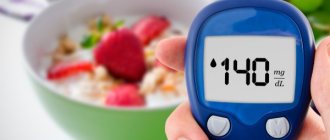Modern pediatrics calls for a thorough examination of children directly from birth. The value of blood glucose in a child today makes it possible to judge the state of metabolic processes, namely, the presence or absence of diabetes mellitus. Therefore, it is important even for parents themselves to know the normal blood sugar levels in children. Its deviation from the norm may indicate the onset of the disease.
According to the latest data, endocrinological diseases are becoming more and more “younger”. The result of a baby’s blood glucose test will be a direct reflection of the condition of his pancreas and metabolic processes. The urgency of the problem lies in the fact that even small deviations from blood sugar norms should make parents wary and be a reason to contact a specialist.
Based on the fact that carbohydrate metabolism has its own characteristics at different ages, blood sugar levels in children will be different.
But, nevertheless, the range of norms is strict for each age. Younger children do not need large amounts of blood glucose; this is also associated with motor activity and mental work, which cannot be said about school-age and teenage children, when energy expenditure is very different from preschoolers. Table - Blood sugar levels in children
| Child's age | Blood glucose level, mmol/l |
| up to 1 year | 2.78 to 4.4 |
| from 1 year to 6 years | 3,3–5,0 |
| from 6 to 12 years | less than 5.6 |
| over 12 years old | less than 5.6 |
Normal blood sugar level in a newborn baby
In the first hours after birth, a general and biochemical blood test is taken from the baby’s heel.
In a newborn baby, normal blood glucose levels can range from 2.7 mmol/l to 4.4 mmol/l. It happens that in a newborn in the first hours of life it is below the lower limit of normal. This condition is physiological, but requires mandatory correction.
Low blood glucose levels are especially dangerous for premature babies. The shorter the fetus was in the womb during pregnancy, the more difficult it is for it to adapt to the environment and adapt to independent development.
A low value of this indicator is just as bad as a high one. The baby's brain tissue does not receive enough glucose. If the actual value of blood sugar in a newborn is below normal, then this condition is compensated for by frequent breastfeeding. When the glucose level is less than 2.2 mmol/l, a diagnosis of hypoglycemia is made and this condition requires drug correction or even resuscitation measures.
By the way, we recommend reading the article Signs of diabetes in women before and after 30
Consequences
Normally, in children under 5 years of age, the sugar content should not exceed 5.0 mmol/l. If the analysis shows a deviation from this value, it is necessary to conduct secondary testing and, if necessary, prescribe additional studies, after which the doctor will tell you why this result appeared.
If the glucose level is indeed deviated from the norm, this will be accompanied by certain symptoms. That is why parents need to closely monitor their child’s behavior. Sugar deficiency usually leads to increased physical activity in the child, and the baby may seem restless.
In addition, the disorder increases the body's need for sweet food, so the child will constantly ask for something sweet. A deficiency of sugar in the body is called hypoglycemia. This pathology is quite dangerous and requires urgent treatment, otherwise the risk of developing hypoglycemic coma increases, which can cause death.
With elevated sugar levels, the child will complain of constant weakness, headaches, dry mouth and will constantly ask to drink. Also, excess glucose can lead to the development of dermatological pathologies, such as itching or redness. If such symptoms occur, the baby should also be urgently shown to a pediatrician, since long-term hyperglycemia negatively affects brain function.
Normal blood sugar levels in children under one year of age
A child under one year of age has low blood sugar levels. This glucose content is explained by the peculiarities of the baby’s metabolism. A child at this age, especially in the first six months of life, does not perform much activity, therefore, little glucose is required as an energy source.
Also, the baby eats mostly breast milk, which is quite balanced and does not lead to high and peak sugar levels. The normal blood glucose level for an infant under one year of age is up to 4.4 mmol/l.
Preparing a baby or child over one year old before analysis
How to prepare for the upcoming cut analysis? You can get a reliable result only if you follow the following recommendations:
- do not feed the baby after 20.00 on the eve of the test;
- the dinner menu should not contain flour products, sweets, soda or juice;
- in order to avoid physiological excess of indicators, you should refrain from sports activities;
- it is necessary to avoid taking all medications, since some of them contain glucocorticoids, which significantly increase the sugar content;
- refrain from brushing your teeth - the toothpaste contains components that affect sugar levels;
- Do not eat in the morning, you can drink clean water without additives.
A blood test for sugar should be taken on an empty stomach.
A one-year-old child should also donate blood only on an empty stomach. This creates a problem, because the baby has a feeding schedule, and skipping meals will be accompanied by whims and crying. It is necessary to feed a small baby who is breastfed. How long does it take for a study to be reliable? In this case, 2-3 hours without food is enough.
This interval is enough for the food to be absorbed. Immediately after donating blood for sugar, the baby can be fed - this way the mother can quickly calm him down.
Normal blood glucose levels in young children and adolescents
As children grow older, their blood glucose levels tend to match those of adults. At one year of age, the norm is a fasting sugar value of up to 5.1 mmol/l, and this value is relevant up to six years.
During this period of children's lives there is a surge in growth and development. The child’s body has adapted to the world around him, nutrition has changed, organs and organ systems work almost the same as in an adult. Blood glucose, if there are no abnormalities, tends to be within the normal range for adults.
If a child between 1 and 6 years of age has a blood test that shows 5.5–5.6 mmol/l, then the blood should be retested in compliance with all the rules. If the result repeats, you need to contact a specialist to clarify the reasons for this result.
From age six through adolescence and beyond, blood sugar levels are exactly the same as those of an adult; the norm is: less than 5.6 mmol/L in capillary blood and less than 6.1 mmol/L in venous blood (from a vein) .
Preparation
A child (girl or boy) should not eat for twelve hours before donating blood from a vein or finger. It is not recommended to give a baby milk (breastfeeding) or to feed with artificial formula (in the evening). Food should be excluded before the study. An hour after the examination, the child can be given food.
If the above recommendations are not taken into account, the risk of false results increases. The sample should usually be taken in the morning and on an empty stomach.
Rules for donating blood for sugar
The blood of a newborn and an infant up to one year old is not often donated, only when a quantitative determination of blood glucose is required.
A child at this age eats every 3–4 hours, which makes it impossible to perform this analysis according to the rules on an empty stomach. From one year on, it is advisable to check your blood glucose levels annually if there are no indications. To obtain reliable figures, the following conditions must be met:
- blood must be donated strictly on an empty stomach (the last meal should be at least 8-10 hours before the test);
- do not brush your child’s teeth (often, children’s toothpastes have a sweetish taste and contain glucose);
- before taking the test, exclude excessive physical activity (since the indicators may be falsely elevated);
- It is undesirable to use medications (some medications can change blood glucose levels).
Why might the indicator be higher or lower than normal?
The value of glucose concentration depends on various factors, including diet, hormone levels and the functioning of the digestive system.
The main reasons affecting the indicator:
- Immaturity of the pancreas due to physiological characteristics. This condition often occurs in newborns. The organ continues its maturation during the first years of life.
- Active phases distinguished during the development of a child. Children aged 6-8 or 10-12 years experience powerful hormonal surges. In this state, body structures increase in size, affecting all indicators, including sugar levels. The increased work of the pancreas under such conditions becomes a source of production of additional amounts of insulin.
Increased glucose is most often associated with the following factors:
- incorrect analysis or incorrect preparation for the test;
- stress or nervous tension that the child experienced on the eve of the study;
- pathologies of the thyroid gland, pituitary gland or adrenal glands;
- decreased insulin production due to pancreatic tumors;
- obesity;
- long-term use of NSAIDs or glucocorticoids;
- unbalanced diet;
- infectious diseases.
Reasons for the decline:
- excessive physical stress without replenishing energy;
- prolonged fasting;
- disturbance in metabolic processes;
- lesions of the nervous system, in which tumors and injuries are observed;
- constant exposure to stressful situations;
- sarcoidosis;
- diseases of the digestive system;
- arsenic or chloroform poisoning.
A fall or increase in glycemia should be a reason for additional examination to determine the source of the pathological process.
Video from the famous pediatrician Komarovsky about diabetes in children:
Causes of elevated blood glucose levels in a child
A blood sugar level that is higher than normal indicates hyperglycemia. If the glucose test result is too high, you need to identify the origin of this.
By the way, we recommend reading the article Which sugar substitute is best for diabetes? Review of sweeteners
There are a number of reasons why it can increase:
- non-compliance with the rules for taking the analysis;
- diabetes;
- diseases of the endocrine glands (thyroid gland, adrenal glands and pituitary gland);
- overweight child.
The most important thing is to understand the root cause. If we take into account diseases, diabetes mellitus most often leads to such an increased level.
Diabetes mellitus is a metabolic disease characterized by elevated blood glucose levels. Type 1 diabetes occurs in childhood, but manifests itself by the age of 25–30.
Warning symptoms - when is testing needed?
Children, especially during the first year of life, undergo various planned tests, among which there is always a sugar test.
In addition to the examination prescribed by the doctor according to the plan, glucose levels should also be determined in situations when the child’s health worsens. This condition can signal various diseases, including diabetes.
Parents should be alert to the following symptoms:
- constantly present strong thirst;
- increased frequency of urination;
- sudden weight loss;
- increased fatigue;
- the presence of a feeling of hunger that disappears only for a short time.
Signs of diabetes in a newborn:
- presence of diaper rash;
- urinary incontinence present at night;
- formation of reddish spots on the forehead, cheeks and chin area.
In overweight children, you should pay attention to symptoms such as:
- irritation that occurs in the perineal area;
- presence of manifestations of thrush;
- the presence of dark spots in the elbow, neck, armpits;
- pustular lesions of the skin surface.
It is important to understand that diabetes develops rapidly in young patients. Ignoring early symptoms can lead to dangerous consequences, including ketoacidosis and coma.
Diabetic complications can occur a month after the first manifestations of the pathological process in children over 3 years of age. A one-year-old child is less likely to be in critical condition.
Causes of low blood glucose levels in a child
Hypoglycemia is low blood sugar. Hypoglycemia is a fairly serious symptom, the cause of which must be determined as soon as possible.
Hypoglycemia is rarely detected in the following cases:
- not eating or drinking enough;
- diseases of the gastrointestinal tract (pancreatitis, gastritis);
- metabolic disease;
- formation in the pancreas - insulinoma;
- sluggish chronic diseases.
Manifestations of hypoglycemia may include anxiety and drowsiness. Severe hypoglycemia is manifested by convulsions and loss of consciousness, which is extremely rare.
Symptoms of hypoglycemia
A reduced blood glucose level indicates different causes of its origin, not similar to each other. In this case, to clarify the etiology of this condition, a full examination and consultation with specialized doctors is necessary.
Diagnostic features
To correctly identify diabetes in children, it is not enough just to get tested. The reason is that deviations from acceptable standards can be a consequence of other processes in the body, for example:
- Eating food before going to the clinic,
- Significant overload - physical or psychological,
- Diseases of the endocrine system - pituitary gland, thyroid gland, etc.,
- Epilepsy,
- Use of certain medications
- Pancreatic diseases,
- Carbon monoxide toxicity.
Indications for unscheduled blood donation for glucose testing
If the child is not worried about anything, the parents do not see any unpleasant symptoms in their baby, then a blood test for glucose levels should be taken annually. If diabetes is hereditary, parents or blood relatives have a history of this diagnosis, regular testing and early detection of abnormalities will protect the baby from the unpleasant consequences of this disease.
You should consult a doctor if your child experiences the following symptoms:
- severe thirst, dry mouth;
- frequent urination with normal drinking regimen;
- unmotivated weight loss;
- weakness, apathy;
- insomnia;
- skin itching.
Symptoms of diabetes
If you have these complaints, you need to consult a specialist in time to exclude the diagnosis of diabetes.
How to help children with diabetes?
If a child's sugar is too high, the doctor will prescribe appropriate therapy. In addition to taking pills and injections, you will have to follow these rules:
- Hygiene of the child’s hands and face, protection of mucous membranes. This is a mandatory condition to prevent itching and purulent lesions of the skin. Parents should apply baby cream to dry skin on their feet and hands to reduce the risk of skin damage.
- Physiotherapy. The doctor may advise the child to go in for sports, but this decision is made taking into account the results of the child’s examination and assessment of the metabolic processes in his body,
- Compliance with the prescribed diet. This rule is especially important if the baby has been diagnosed with diabetes.
What affects the results of the analysis?
Before taking the test, the child must be absolutely ready for this, because many factors are irritants for his body. During the previous 3 days before diagnosis, you must follow a normal diet, without limiting carbohydrates. And you must stop taking medications that can affect the results.
You should not eat food 12 hours before diagnosis. When the child’s blood is already taken for analysis, he should not drink water or eat food. All that is required of him is to sit or lie quietly. If you feel weak or faint, excessive sweating, or have a cold, stop the study.
All of the above factors directly affect the results that will be obtained after deciphering the material. Only if they are strictly followed can one be confident in the accuracy of the results. Otherwise, you will need to donate blood again.











